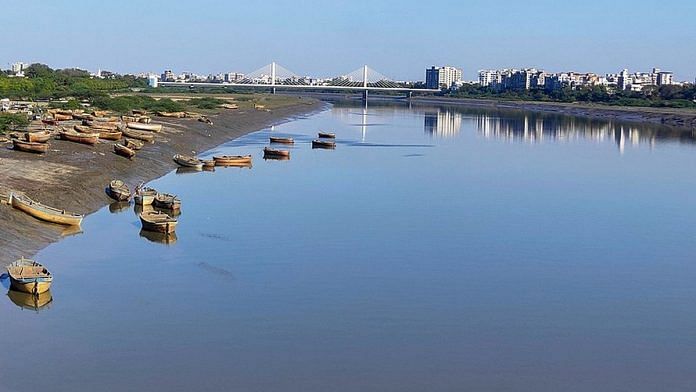New Delhi: Amid large-scale protests by tribal communities in Gujarat, where assembly elections are due later this year, the Union government has decided to put the Par-Tapi-Narmada river-linking project on hold.
The central government, however, is not giving into the demand of the Opposition Congress to drop the project altogether, sources in the Union Jal Shakti Ministry said. The government, they added, is only stalling the project until Gujarat and Maharashtra, the two states through which the rivers flow, can come to a “consensus”.
Plans to put the project on hold have been greeted with some scepticism by the Congress. At a press conference Wednesday, Sukhram Rathva, Congress Leader of the Opposition in the Gujarat assembly, said the real reason why the project was kept on the backburner was to “shant karana (shut up)” the adivasis (tribals) “until the elections”.
The state BJP leadership, meanwhile, has also distanced itself from the project. Gujarat Irrigation Minister Hrishikesh Patel Tuesday said in the assembly that Gujarat has asked the Centre to not go ahead with the project.
Also Read: In deadly dry Bundelkhand, Ken-Betwa link finally seems real. But critics have questions, fears
What is the Par-Tapi-Narmada link project?
The Par-Tapi-Narmada river-link project envisages transferring ‘surplus’ water from the Western Ghats in Maharashtra to the semi-arid regions of Saurashtra and Kutch in Gujarat for “irrigation, hydropower and water supply benefits”.
The project involves linking the three rivers — Par, Tapi, and Narmada, all of which flow through districts of both Maharashtra and Gujarat — via a canal. The project also includes the construction of seven dams, three weirs, and six power houses.
Finance Minister Nirmala Sitharaman, in her Budget speech on 1 February, announced that the detailed project reports (DPRs) for five river-linking projects, including Par-Tapi-Narmada, had been finalised. She added that “once a consensus is reached among the beneficiary states, the Centre will provide support for implementation”.
However, the proposed project hit snags ever since it was announced, with residents in tribal belts holding huge protests against their anticipated displacement. The Congress vocally supported these protests, while the Gujarat BJP president C.R. Paatil also appealed to the party’s central leadership to reconsider the project.
It is worth noting that the river-link project is one of several that have been in the pipeline for decades.
In 2002, the NDA government under Atal Bihari Vajpayee proposed a new National Water Policy that included transfers from “surplus” to “deficit” river basins for agricultural and other purposes.
The National Water Development Agency identified 30 links for preparation of feasibility reports. Apart from the 5 projects whose DPRs have been prepared, a sixth — the Ken-Betwa project in MP and UP — received the Union Cabinet’s nod last year.
The protests
Since the announcement of the project, residents of the region, especially in the tribal belts have been protesting vociferously. The Gujarat Congress has also taken up cudgels on behalf of the tribals and has participated in rallies against the river-linking project.
“In the past 30 years, because of different projects, adivasis have been in danger. Jungles and land are also being destroyed. We are not against development but we don’t want it at the cost of adivasis’ destruction,” Anant Patel, Congress MLA from Vansda, told ThePrint.
A big dam is being built by the government under the Par Tapi Narmada link project in Dang dis. of Gujarat. Due to which thousands of tribal villagers re sure to be displaced. After all,till when will the tribals be uprooted in the name of mining, dam,sanctuary? #AdivasiSatyagrah pic.twitter.com/e5A5nLf5Pl
— Tribal Army (@TribalArmy) March 25, 2022
The state BJP leadership, in an election year, also seems to have been discomfited by the protests and appears keen to avoid alienating the adivasi community.
Earlier this week, the state BJP president C.R. Paatil and other top leaders from Gujarat met Home Minister Amit Shah, Finance Minister Nirmala Sitharaman, and Jal Shakti Minister Gajendra Singh Shekhawat in New Delhi and appealed to them to put the project on hold.
Paatil also told reporters that the BJP would “never do anything that will lead to tribals losing their land and affect their interest”.
The question of ‘consensus’
The Jal Shakti Ministry has not made mention of the protests but has said that the proposed river-linking projects — Damanganga-Pinjal and Par-Tapi-Narmada — involving Gujarat and Maharashtra will be dropped only if the two states fail to reach a consensus between them.
“As of now, there is no consensus. The projects will not be implemented till a consensus is reached,” a source in the Jal Shakti ministry said.
However, Gujarat and Maharashtra had earlier agreed on the DPR, although they are apparently no longer on the same page.
In May 2010, Gujarat, Maharashtra, and the Centre first signed a tripartite Memorandum of Understanding for the preparation of a DPR for the Par-Tapi-Narmada link.
According to documents dating to 2017, available at the Jal Shakti Ministry’s website, the then Water Resources Minister Nitin Gadkari held a meeting with the then CMs of Maharashtra and Gujarat, Devendra Fadnavis and Vijay Rupani, on 25 September 2017. In this meeting, the two BJP chief ministers agreed to implement the project.
Gadkari held another meeting on 16 January 2018 with representatives of the governments of Maharashtra and Gujarat to review the status. Several other meetings took place subsequently too, including one convened by then chief secretaries of both states on 7 September 2018 for the finalisation of the MoU to implement the project.
While the BJP is still in power in Gujarat, Maharashtra now has a coalition government under the leadership of Shiv Sena’s Uddhav Thackeray.
(Edited by Asavari Singh)
Also Read: Shift focus from dams, what India needs is better water management: Top water conservationist



